Patty Berganza is a chatty 16-year-old with a mouthful of braces, a thick mane of black hair, and a lightning-fast brain. The last of these left her so bored at her previous Los Angeles high school that she racked up more than 49 unexcused absences in one year and earned a reputation as a slacker. She never thought about college, because nobody ever talked about it. Indeed, she says of her previous high school, “I don’t think my teachers even knew my name.” In many ways, Patty represents countless students who graduate at abysmal rates but who have the capacity to do infinitely better. Unlike others, she found a new school that has helped her tap that capacity.
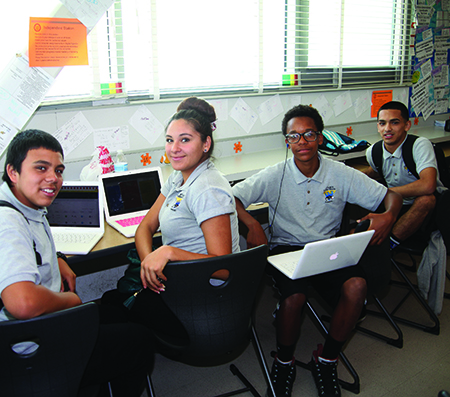
Where Patty once routinely slumped at the back of the classroom, she now perches front and center, attentive and engaged. She has flown ahead of her peers in math, and earned an overall grade-point average of 3.28, and talks hopefully about applying to the University of California, Berkeley. What is remarkable is that Patty is realizing that potential in a classroom with 48 students.
That’s right: at the Alliance Tennenbaum Family Technology High School, a charter school on L.A.’s east side, every teacher is responsible for at least one-third more students than any mainstream educator would recommend. But these are not traditional classrooms. The school uses a hybrid model that combines online and traditional instruction and offers students three different ways to learn. On this particular fall day, 16 students are getting traditional in-person instruction in Algebra I from teacher Wendy Chaves; roughly the same number are doing math problems online; and still others are gathered in clusters of four tutoring each other.
As public budgets shrink, and technology enables increasingly individualized instruction, schools are justifiably looking toward online models for ways to improve student performance. The criticism of online learning has long been that, however cost-effective, it cannot replace the human element in teaching. And that is certainly true. The beauty of a hybrid model, also known as blended learning, is that it enhances the human element. Computers help students to achieve competency by letting them work at their own pace. And with the software taking up chores like grading math quizzes and flagging bad grammar, teachers are freed to do what they do best: guide, engage, and inspire.
An increasing number of educators and policymakers see blended learning as one of the most promising means of educating students with a wide variety of learning styles and abilities. Tennenbaum, which opened in 2011, is one of its pioneers. The school graduated its first class of seniors in June 2013, and only 6 out of 74 were, at the time of this writing, unlikely to make it. (When they arrived, only half of these students were on track to graduate.) In the months since it adopted the rotational model, known as Blended Learning for Alliance School Transformation, or BLAST, Tennenbaum has learned that adaptation to radical change does not come quickly or easily. But it is showing that with commitment and a willingness to experiment, blended learning has great potential not just for improving efficiency and reducing costs, but for boosting student achievement across the board.
A Leap of Faith
Tennenbaum, which was recently renamed to honor a big donation by the founder of a Los Angeles hedge fund, is part of Alliance College Ready Public Schools, a charter management organization with 14 high schools and 6 middle schools throughout Los Angeles. Its CEO is Dr. Judy Ivie Burton, former area superintendent of the Los Angeles Unified School District. The students share a sprawling concrete campus with four other schools in an industrial neighborhood in the shadow of famed Griffith Park. In contrast to the affluent towns on the west side of the park, only 40 percent of adults in this neighborhood graduated from high school. Ninety percent of the students at the school are Latino, 73 percent qualify for subsidized lunch, and 65 percent arrived lacking credits they would need to graduate on time.
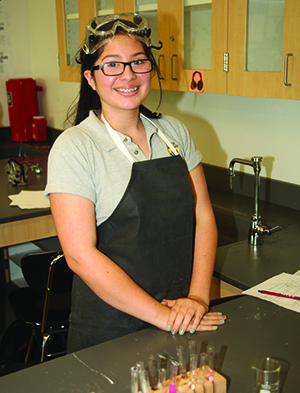
Blended learning was not on the table when the Alliance network first considered the possibilities of technology for improving instruction. Instead, the founders planned to offer online courses for dropouts to recover credits. But principal Michelle Tubbs, a veteran of the classroom who holds a doctorate in education technology, had conducted a pilot program with blended learning at an Alliance school in the city’s Watts neighborhood, where the average freshman read and did math at the 4th-grade level. Her team there had used data aggressively to shape instruction, and by the end of the year, students were performing on average at an 8th-grade level. It was still not optimal, but it was a big jump from far behind. “We knew we were onto something pretty powerful,” said Tubbs. Later, she dove into the deep end at Tennenbaum, instituting blended learning across all subjects and grades.
Patty Berganza’s original high school, like the vast majority of schools in the United States, used the familiar model known as “whole group instruction.” Blended learning blows this model up. While teachers still work with entire groups, students also break off for independent work and to work with peers. This is not distance learning, a lone kid sitting at home in front of a monitor. Students are in the same classroom no matter what mode of instruction is being used.
Tennenbaum’s move to blended learning was, to a large extent, a leap of faith. To date, there has been relatively little research on the effectiveness of blended learning in U.S. schools, and what research does exist cannot necessarily be generalized. A 2010 research review by the U.S. Department of Education found that students who took all or part of their courses online performed better on average than students who were taught face-to-face. The evidence also suggested that instruction that combined online and face-to-face methods was better than either method by itself. But the review was limited: covering just 45 studies, it was based largely on postsecondary experiences because of the dearth of data for the lower grades.
In districts where there are data, the message is unclear. For example, Los Altos, California, an affluent district, used Khan Academy software to teach 7th graders remedial math and saw proficiency rates rise from 23 percent to 41 percent. Yet Chandler, Arizona, the New York Times recently pointed out, has spent $33 million on technology in recent years only to see its reading and math scores stagnate, even as statewide scores rose.
As the skeptics agree, the question is not really whether online instruction is a superior medium in and of itself. The Department of Education’s survey found that success with online learning depended on time spent on instruction, as well as the quality of the curriculum and pedagogy. In other words, it’s not just the technology that counts: it’s what teachers do with it. A SMART Board in the hands of an untrained educator is nothing but a high-priced overhead projector.
Tom Vander Ark is a former state superintendent and Bill & Melinda Gates Foundation official who now runs a company that invests in educational technology. He concedes that millions in recent investments have brought some disappointing results, but, he says, “that’s because it was layered on top of the existing batch-print model of schooling.” He says there are “hundreds” of studies that have proven the efficacy of online and blended learning. As examples, he points to Rocketship, a group of schools in California serving low-income students that credits their high achievement in part to a daily two-hour computer lab; Carpe Diem, a top math performer in Arizona; and Robert A. Taft Information Technology High School, a Cincinnati school that converted to a technology focus and saw its graduation rate soar from 21 percent to more than 95 percent. Vander Ark urges patience. “The ability to personalize learning has dramatically improved in the last 24 months,” he says, “and will be much better 24 months from now.”
Mastering the Material
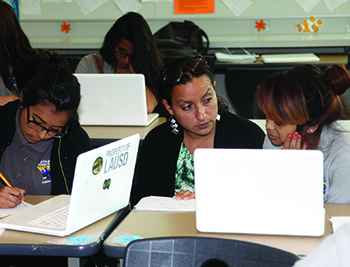
BLAST shows promise precisely because it uses technology in a way that is systematic and intentional, and because it works toward mastery of learning. Each day is broken into two-hour blocks with 40 minutes for each station. Students report to stations based on what regular pre-tests have shown they can do. The low performers go right to direct instruction with the teacher, the high performers start with the collaborative session, and those in the middle start with online work.
Let’s say the English lesson is about effective use of literary devices. Students might start with a teacher-led lesson on metaphor, personification, and the like, followed by an online tutorial on the MY Access! writing program. They write a short essay, which the computer scores for mechanics and grammar. If the student has too many mistakes, he takes another tutorial and writes the essay again. He sets himself a deadline (say, all clean by the third draft), and when he has met it, submits the piece to the teacher for feedback on meatier qualities like content and organization. Finally, in the collaborative session, students critique each other’s work, making suggestions for improvement based on what they have learned from the teacher and online.
Crucially, only when students prove mastery over the material do they move ahead. A D-average freshman year does not a sophomore make. Thanks to the online programs, students can go over their lessons again and again. And all the while, the software is recording every keystroke, collecting a wealth of data about what students are learning and how. Does the student best understand a concept when it’s delivered in direct instruction, or does the lesson click when she learns online? Does she show notable improvement after tutoring with her peers? How many tries did it take her to get a question right? How fast does she work? The software records it all.
Daily assessments, such as online quizzes, help students see where they are, and quarterly benchmark assessments let them see where they fall in relation to their peers. The results appear on computer dashboards designed for students and teachers, and, in the case of benchmark assessments, they are posted on bulletin boards for the world to see. “It is important to get the kids, not just the teachers, to use the data,” says Tubbs. “They know that if they want to go to U.C., they aren’t going to get there with an 800 Lexile score.”
This concept of owning learning is key to the BLAST philosophy. Salman Khan, the former hedge fund analyst who founded the popular Khan Academy series of educational videos, spells out the virtues of blended learning in his new book, The One World Schoolhouse (see “To YouTube and Beyond,” book reviews, Summer 2013). Students are not naturally passive, he points out; they actually have to be taught to be passive, to sit still and listen to lectures. And it makes them less engaged. By contrast, he says, active learning—owned learning—lets students themselves determine where and when learning will occur.
The traditional model also leads to what Khan calls the Swiss cheese problem: holes in student knowledge. When a high school is producing seniors who read at an 8th-grade level, it means everybody is moving on at the same time, whether they are ready or not. A grade of 95 percent might represent an A, Khan points out, but the student may be missing essential information that he needs to build on later. “It’s why calculus is so likely to reveal the cracks in people’s math foundations,” Khan says. “In stacking concept after concept, calculus is the subject most likely to tip the balance, reveal the dry rot, and send the whole edifice crashing down.” The competency model is designed to prevent learning gaps and to fill in the gaps that may yet occur.
A Laptop for Every Student
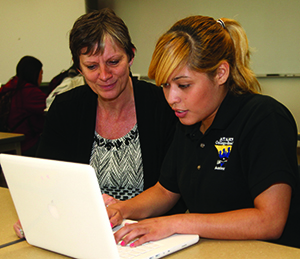
A critical feature of Tennenbaum’s curriculum is that every student is issued a laptop computer that is checked out at the beginning of the school day and returned at the end. This practice has not been universally embraced, and it is fair to say that not everyone at Alliance thought it was a good idea, either. Within the Alliance network, Tennenbaum is the only school that gives students their own machines. This year the school has seen two screens crack and two hard drives crash, and a few computers have gotten “lost.” But considering that 450 computers are in use six hours a day, Tubbs doesn’t think the track record is too bad.
Besides, she says, the MacBooks serve a larger purpose, one that is integral to instilling responsibility in young people. “When you look around in a socioeconomic environment like this,” says Tubbs, “that computer represents trust and belief.” Tubbs recalls one day last year when the teachers had to line up the desks in traditional rows to accommodate the state’s standardized testing regime. The teachers took the laptops away during the tests, which lasted the morning, but they didn’t move the desks back to their clusters or return the computers in the afternoon. The result? “Chaos and mayhem,” Tubbs says. “There were eight kids sent to my office, when we rarely have discipline problems. I said ‘Why are you acting this way?’ And they said, ‘Miss, you put us back in the traditional classroom. You took our computers!’”
That reaction raises the question of whether Tennenbaum students will become too dependent on computers. Tennenbaum offered a dual-enrollment, college-level art class that was taught by an instructor who used the classic lecture format: two hours of PowerPoint with students frantically scribbling notes. Tubbs advised the students that this structure could be their future at a community or four-year college. Were they prepared for that? They said they were. “They said, ‘We know what we have to do, but we know that we can also divide up into three circles if we had to during study groups.’ I thought that was pretty powerful. They know they have to adapt to the world that’s out there. And now they have a toolkit that is going to promote collaboration, which we all know is one of the major skills that every employer is looking for.”
A Vertical Learning Curve
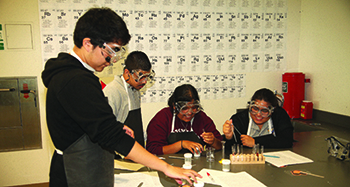
The teachers at Tennenbaum are for the most part young (only two have more than five years of experience) and conventionally trained. Some might see both as a handicap, but Tubbs says these are educators with a passion for problem solving, not just problem identification. And professional development is a daily affair. By regularly tweaking the model and sharing their experiences, teachers generate new ideas. For instance, when teachers were feeling overwhelmed by doing daily agendas, two teachers tried completing them weekly, and soon everyone else was following suit. Likewise, the school switched the math software from Khan Academy to Virtual Nerd based on student preferences. “It’s action research every day,” says Tubbs. “We are the ones who are pioneering this, so we are the ones who have to be willing to test and try, plan and retest.” Otherwise, Tubbs says, her teachers “are just really smart, and they have heart… Those are two things I am looking for. Everything else I feel I can teach you.”
If Tubbs is pleased with her human instructors, she cannot always say the same for their online counterparts. “There is no A-plus software out there,” Tubbs says. “Most of it is C-plus or below.” Problems with the English software, revealed by disappointing student performance on benchmark tests, caused teachers to shorten the online component of some English courses and depend more on face-to-face instruction. The school has .added an Internet-based program to boost writing skills. The computer can grade student essays on grammar and mechanics, but students can fool the computer with content and organization.
Ramisi Dilley, the BLAST coordinator at the school, says software can improve with teachers’ feedback. For instance, the students use Revolution Prep to take a pre-test for the California High School Exit Examination (CAHSEE). The test groups students individually and together on how well they are performing on a certain standard, such as factoring in Algebra I. But while the software is helpful at separating out strands for each student, it doesn’t isolate data in other ways that would be helpful, such as for targeting students for CAHSEE “boot camp.” It may find that a student is on track to pass the assessment overall, but it does not pinpoint student weaknesses in one particular area. Conversely, the program may find that the student is slated to fail the test overall, but does not note that the student performs exceptionally well in one area. “I broke down the data and I saw these outliers,” says Dilley. “But this took me two days. This is the kind of thing the software companies need to do for us.”
Dilley’s research also turned up flaws in Achieve3000, a program the school uses for reading comprehension. Teachers started to notice that some students performed better when they took the reading tests online at home. Because the students had opened the program after hours, it wasn’t capturing their progress or moving them ahead. In response to feedback from the school, the program has changed. “We are constantly making adjustments,” Dilley says. “It’s like a machine that needs oiling all the time in order to work properly.”
The goal of blended learning is to enhance student learning, but, like other schools, the Alliance network also needed to save money. The model appears on track for doing that, despite first-year shortfalls. The school estimates that it has saved $963 per student based on three fewer teachers per student and savings on the textbooks the school no longer needs, but it had the added costs of laptops and technical support. For school year 2011−12, that amounted to a net loss per student of $201. According to a report by the Michael & Susan Dell Foundation, the school district, which funded the campus, has more control over student enrollment than the charter management organization does. The school was created to relieve overcrowding, but the district funneled fewer students there than projected. If the school had enrolled 450 students as planned, the report says, it would have $14 per student to reinvest. Overall, the recurring technology-related costs of the blended model come to about $1,164 per student. Alliance has expressed confidence that with rising enrollment and the expansion of its distance learning component, it will be able to sustain itself without foundation support.
Individualized Instruction for All
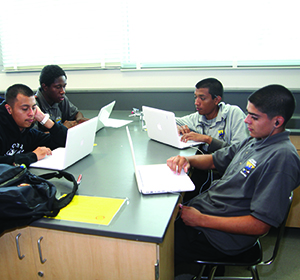
Individualized instruction is an ideal that has long been available only to those who could afford to pay for elite tutors. Blended learning offers a new way. True, the jury is still out on which models work and on how they work best. At Tennenbaum, students show progress on most benchmark assessments, but in a few cases they have shown only modest progress or declines. Constant innovation virtually guarantees mistakes. And blended learning models can dilute the power that comes when everyone is working in concert on the same thing. Some also say that students have to be particularly motivated to succeed with blended learning.
BLAST shows that for technology to make a difference in student learning, it must be integral to instruction, and it must come with humans attached. It is a fact deeply unsettling to the teaching profession that the increased use of technology is likely to reduce the overall number of teachers we need. But we will still need as many good teachers as ever. In their wise hands, harnessed in the right way, the power of technology can be transformative.
Susan Headden is senior associate for public policy engagement at the Carnegie Foundation for the Advancement of Teaching. This article is adapted from “The Right Mix: How One Los Angeles School is Blending a Curriculum for Personalized Learning,” Education Sector (February 2013).
This article appeared in the Fall 2013 issue of Education Next. Suggested citation format:
Headden, S. (2013). The Promise of Personalized Learning: Blending the human touch with technological firepower. Education Next, 13(4), 14-20.


